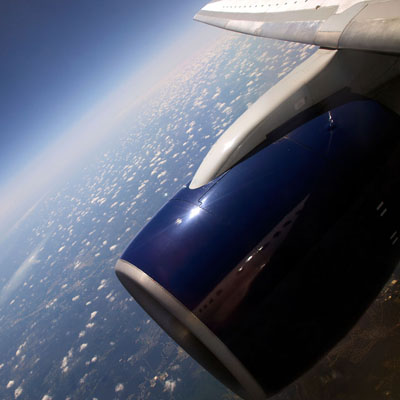When we consider the impact of aviation on the environment, we often think of carbon emissions and low carbon fuel options. But another important type of emission to consider is water vapour – and the impact that the contrails formed by these water vapour emissions at high altitude can have on global warming. Cranfield alumna Dr Sarah Qureshi (PhD Aerospace 2016), winner of the 2020 Distinguished Aerospace Alumna Award, is the CEO and Co-founder of Aero Engine Craft. In this article, Dr Qureshi discusses why the industry needs to be considering water vapour emissions and shares insights into the innovative technology she is developing – offering a solution which not only eliminates contrails, but transforms the water emissions into a resource.
Types of aviation emissions
Aviation emissions are divided into two categories: carbon emissions and non-carbon emissions. Carbon emissions mostly comprise of carbon dioxide - a phenomenon which is common to both the ground and the air and has a very wide spectrum of industrial contributors. As a result, there is already a fairly good understanding of carbon dioxide and how it contributes to global warming - as well as methods to mitigate it and to reduce carbon emissions both on the ground as well as in the air. A lot of solutions have been developed for ground-based industries to reduce carbon dioxide and these solutions are now being in some way transposed into the air to reduce carbon emissions released by aircraft in the sky.
However, another form of emissions specific to the aviation industry that must be considered is water vapour. The combustion by-products of any hydrocarbon fuel burn are water vapour and carbon dioxide. Therefore, water vapour is one of the abundant non-carbon emissions produced by aviation. Since water vapour has a variable residence time and lower residence time as compared to carbon dioxide, on the ground it is recycled quickly and does not contribute to global warming. However, at higher altitudes this water vapour acts as a greenhouse gas and also forms contrails due to low ambient temperature and ambient pressure - and therefore has a major role in contribution to global warming.
In that context we can say that the global warming contribution of water vapour is a phenomenon which is specific to the aviation industry and therefore the level of understanding on it is limited. Hence it is crucial to talk about it, which is one of the roles that I have undertaken, along with the development of the technology itself at Aero Engine Craft.
Contrail-induced global warming
Recent trends indicate that the aviation industry is now being redefined by numerous environmental challenges, which include contrails. Contrails are artificial cirrus clouds that are created by the atmospheric condensation of the supersaturated water vapour that is present in the exhaust emissions of aircraft as a combustion by-product.
According to the emission index of water, 1.25kg of water is produced for every 1kg of kerosene fuel burn. In the wider context of the environmental impact of aviation, contrails created through aero emissions disturb the atmospheric balance and affect the earth’s radiation budget - either by reflecting sunlight back to space or by trapping the infra-red radiation emitted by the earth’s surface (the greenhouse effect). The radiative effect of contrails is said to vary around 10mW/m2. According to the Intergovernmental Panel on Climate Change (IPCC), contrails cover 0.2% of the Earth’s surface at present and this is likely to rise to 0.5% by 2050. This constitutes a considerable proportion of aviation’s contribution to global warming, at 25K watts. Studies have also proven that the global warming potential of contrails is five times that of carbon dioxide. Therefore, when it comes to reducing the environmental impact of aviation - a reduction in the water footprint is equally important as that of the CO2 footprint. Contrail avoidance therefore should be a part of the current focus of the aviation industry.
Aero Engine Craft is developing technology to eliminate contrails - and transform fuel emissions into a resource
Aero Engine Craft Private Limited is developing contrail-free aero engines for the reduction of global warming. As well as eliminating contrails, the technology is capable of inducing artificial rain during aircraft flight through on-board water recovery from fuel emissions; creating a vision of the future for the aviation industry where it can not only reduce aviation-induced global warming, but also adopt an approach to treat the fuel emissions as a resource.
A revolutionary technology is employed that eliminates contrails at source and recovers water from fuel exhaust emissions as a net-positive product. This is a true definition of a disruptive technology; a global first attempt to create water within the aero engine from the exhaust plume during flight, carry it on board and release it as rainfall prior to landing. Our product is a low-cost alternative to aero engine redesign - offering revenue potential to the aviation industry while solving a crucial environmental challenge.
The core technology is based on the research outcome of my PhD study, supervised by Professor Pericles Pilidis and conducted at the Propulsion Centre, Department of Aerospace Engineering, Cranfield University UK, in collaboration with the inventor of the technology Mr. Masood Latif Qureshi.
Aero Engine Craft is set up to convert this patented technology into a full-scale commercial application ready to be used by modern civil transport aircraft. The business is modelled as a circular economy - creating value for global engine manufacturers, aircraft manufacturers and airlines by providing compliance to environmental standards and revenue through emission trading and artificial rainfall. Aero Engine Craft aims to mark the beginning of the first contrail-free aircraft flight in the world!
Contrail-free aero engines: how the technology functions
A contrail-free aero engine is designed to reduce aviation-induced global warming through the development of a pressure-based turbomachinery, defined as the water expeller, that is introduced as a modular attachment to a standard aero-engine. It encompasses a condensation and containment mechanism for the exhaust water vapour content of emissions. This mechanism intends to eliminate the source of contrail formation. This is a unique pressure-based condensation system devised specifically for airborne applications and is a novel addition to the family of gas-turbine components.
Since water is created during the course of condensing the emissions, artificial rainfall can be induced at an altitude of naturally occurring low level precipitation clouds while the aircraft is descending and flying below its cruise altitude. Direct rainfall can be precipitated to the ground within a radius of 17km of the landing airport, depending on the direction of the approach of the aircraft to the airport, if water is released from the aircraft once it descends to an altitude of around 2500m (nearly 8000 feet) above sea level. This water can continue to be released until the aircraft lands. The time duration for this process would be around five minutes.
Not only does our technology reduce the aviation industry’s contribution to global warming by effectively eliminating contrails, it also signifies a positive contribution by the aviation industry towards meeting the global challenge of water scarcity by creating localised rain in the process. Artificial rain can be a major revenue generator for the airlines employing this system. The implementation of this technology shall shift the negative impact of aviation on the global environment towards a positive contribution from the aviation industry towards the environment.
Our primary market includes global aero engine manufacturers for the installation of the core device into the engine (both in-service and pre-sales engines) and global airframe manufacturers for the integration of the auxiliary systems into the aircraft. This is essentially a monopolised business. At present, there are three major market players for commercial engines: Rolls-Royce, GE Aviation and Pratt & Whitney. Similarly, there are two major aircraft manufacturers in the world: Airbus and Boeing. Currently there are 55,800 engines in service, growing at a rate of 3.4% per year. The base year is 2015 and the growth rate is applied according to industry projections. In addition, there are 25,000 commercial airplanes with an average of 2 engines per aircraft. A conversion rate of only 5% engines per annum is assumed. Nearly 3,500 engines will acquire this technology in 2024. This number could then be extrapolated according to the annual growth rate.
The concept is very unique, and the design is patent protected. It’s airworthiness, simplicity, and ease of implementation within the ecosystem sets it apart. The design of this device and the technology involved in its development are synergistic with the current technology employed by aero engine and airframe manufacturers. As a result, this device can be easily incorporated within the existing framework of aero engine and aircraft design. Another unique specification of this technology is that it is an add-on and can therefore be integrated with existing aircraft engines. This means it is applicable to both in-service and pre-sales engines. Manufacturers lease each component of an aero engine to airlines in a modular fashion, and either charge once to cover the cost or use a “performance by the hour” model. Our device can also be treated as a module and charged for in a similar fashion once the engine is upgraded with this technology.
Other environmental technologies in the aviation industry still need to address the issue of contrails
A number of recent posts have referred to hydrogen fuel aviation as a zero-emission technology - and this can lead to scientific misconceptions. Hydrogen-powered aviation is not zero emission; it is only a zero-carbon technology. Hydrogen fuel has an emission index of 9 compared to kerosene fuel which has an emission index of 1.25. This means that we would release 9kg of water as a combustion by-product for every kilogram of hydrogen fuel burn, as emissions into the atmosphere. This water is either introduced into the atmosphere as a greenhouse gas that contributes to the greenhouse effect and/or contrails, or - depending upon the ambient conditions - is sometimes as induced cirrus.
The scientific research community has a consensus on the global warming impact of contrails and induced cirrus in the atmosphere, which has been quantified to be much more than that of carbon dioxide. I support all disruptive technologies including liquid hydrogen, which is a great move towards de-carbonisation - but we need to be accurate with the use of terminology.
Environment-centric aviation technologies are the solution to the critical recovery of the aviation industry from its spiral nose-dive. Examples of solutions which could help to reduce the impact of aviation on our environment include:
1. Hybrid-electric aircraft: A combination of batteries and a gas-turbine engine. The concept is also known as Distributed Propulsion. A low-carbon technology for long-haul large aircraft
2. The all-electric battery powered aircraft: A zero emission technology for short-haul small aircraft only.
3. Liquid hydrogen fuel: A zero-carbon technology for long-haul large aircraft.
4. Hydrogen fuel-cells: A zero-carbon technology for short-haul small aircraft.
5. Ammonia-fuelled combustion: A zero-carbon technology for long-haul large aircraft.
6. Sustainable Aviation Fuels (SAF): A low carbon technology for both small and large aircraft
7. Supersonic Commercial Aircraft: A low noise technology for long-haul large aircraft.
Other than in the case of the all-electric aircraft, the non-carbon emissions - contrails and nitrous oxide - would need to be addressed in all of the above technologies. Given their state-of-the-art nature, some of these technologies are only applicable to small aircraft as they cannot be scaled up for large aircraft. Others are only efficient for large aircraft and cannot be optimised for small aircraft.
About Dr Sarah Qureshi
Dr Sarah Qureshi (PhD Aerospace 2016)
CEO & Co-founder Aero Engine Craft Private Limited
Visiting Academic, Aerospace, Transport and Manufacturing, Cranfield University

Sarah obtained a PhD degree in Aerospace Propulsion under the supervision of Professor Pericles Pilidis on a thesis entitled “Contrail-free Aero-engines” whereby she researched the development of an environment-friendly aero-engine, which was derived from a novel patented technology. During her initial PhD research, Sarah assisted the inventor with patenting the contrail-free aero-engine. The invention has been granted two international patents and has tremendous potential in bringing about an environmental revolution in the context of aviation.
Dr Sarah Qureshi, along with the inventor of the technology, Mr. Masood Latif Qureshi, has now set up Aero Engine Craft (Private) Limited, as Pakistan’s first commercial aero- engine R&D company to convert this patented technology into a full-scale application for the global aviation industry. Prior to this, Sarah completed her MRes degree in Aerospace Dynamics at Cranfield University with Dr James Whidborne. Her research involved the design of an autopilot for unmanned aircraft (UAVs) in formation flying for mid-air refuelling.
She has recently co-invented and filed a patent for a supersonic commercial aircraft engine. Sarah is a licensed pilot and learned acrobatic flying with flight instructor Richard Rogers while at Cranfield. Prior to her postgraduate studies at Cranfield, Sarah graduated as a Mechanical Engineer from Pakistan and gained work experience in the local industry.
You can also watch a video introducing Sarah below:
Get the latest updates from Dr Sarah Qureshi
Find Dr Sarah Qureshi and Masood Latif Qureshi on LinkedIn.
Get the latest updates: follow Dr Sarah Qureshi on Twitter and subscribe to her YouTube channel.
Visit the Aero Engine Craft website.





